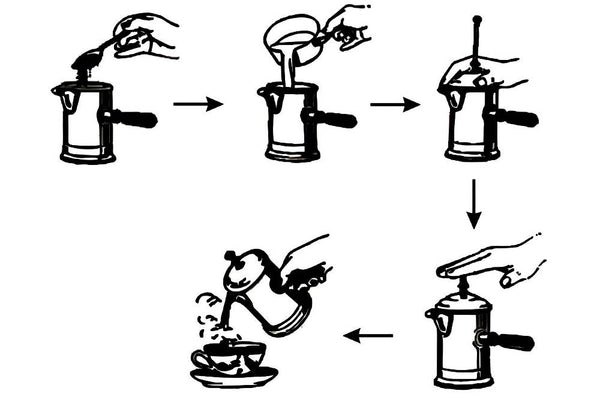Below is a story about the creation and distribution of one of the most popular devices for making coffee.
Around the world this product is called differently, some examples include: "Coffee plunger", "cafetiere" or "coffee press". Obviously, the meaning does not change its simplicity and efficiency, which is what the French press is well known and loved for, since it's not required to use electricity or a stove.
How the French Press works
Rumor has it that one Frenchman forgot to add coffee prior to pouring the boiled water in a cup and decided to do it after instead. However, all coffee particles came up to the surface, which made it impossible to drink.
The clever Frenchman decided to buy a metal strainer from a merchant, which lowered the coffee grounds to the bottom of the container.
This is how a modern French press works and how to french press coffee. There are no separate reservoirs for prepared water and/or the finished drink, unlike in a geyser or a drip coffee maker. Only a piston is used to separate the coffee grounds in the French Press method: it lowers the coffee particles to the bottom of the container by “straining” and providing a clear coffee drink for anyone to enjoy.
Who invented the French Press - French or Italians?
Part of the name makes one think that its origin must be France; however, the truth is - it's not entirely so.
The first version of the French Press was, in fact, invented by the French. Back in 1852, Mayer and Delforge demonstrated a draft of their invention - a very simple container with a flat sieve inside, which lowered the coffee grounds to the bottom, according to the illustration below.

The history of the cafetiere. The very first French press. Mayer and Delforge 1852. Credit: beandelivered.com
Mayer and Delforge’s invention scheme.
What's interesting, the first French Press patent was actually registered in Italy in 1928: Attilio Calimani and Giulio Moneta came up with a device very similar to that of Mayer and Delforge’s.
First commercial success: Cafeolette - another French invention.
All previously invented devices were united by one but significant flaw - they remained only at the initial level of the idea. The first official French Press device appeared in France in 1913. The Frenchman Louis Forest created a small teapot with a piston in the form of a metal filter, and called it “The Cafeolette”.
Cafeolette’s method.
Unlike modern French Presses, the Cafeolette method was intended for preparing coffee with milk only: ground coffee was poured simultaneously with hot milk, left to stay for a few minutes, and followed by filtering.
Italian Bondanini and the most popular French Press

How Cafeolette works. Credit: tastycoffee.ru
The most popular French press device was created by Swiss-Italian designer Faliero Bondanini in 1958 and looked like a steel-rimmed glass container with a metal filter inside.
Bondanini registered the patent and started the production of the French Press called “ Chambord” at the “Martin S.A.” French Factory. This is how the Italian version of the French Press spread out in France and became a hallmark of French cafes.
In the 1960s, one of the investors of “Martin S.A.”, opened a French Press production business "La Cafetiére Classic" in the UK. It is believed that the “The Ipcress File” Movie, which came out in 1965, contributed to popularity of the French press: Michael Caine’s hero prepared freshly ground coffee using this particular method.

Chambord © Youtube.com
Later on, the French press started to get distributed widely in Denmark, thanks to the Danish company “Bodum”, which even bought the rights to the invention and production in 1991.
The same company created about 300 models (a huge variety of designs and materials) of French Presses which exist nowadays, including the original “Chambord”.
Modern French Press

The classic French Press is made out of glass, however - other materials are also widely used for manufacturing of alternative versions.
Some examples include: the Canadian “Espro Press'', which is made out of stainless steel and a double filter; the American Press, with a closed chamber for ground coffee (no need to clean the filter from particles every time);
the Rite Coffee Press, another American device with a thermometer and a timer installed (a Ceramic version is available).
All above-mentioned versions operate by the same principle and all you need are the instructions on how to brew a delicious “French Press” coffee properly.
You can find how to make french press coffee on our website under the “brewing methods” guideline.

